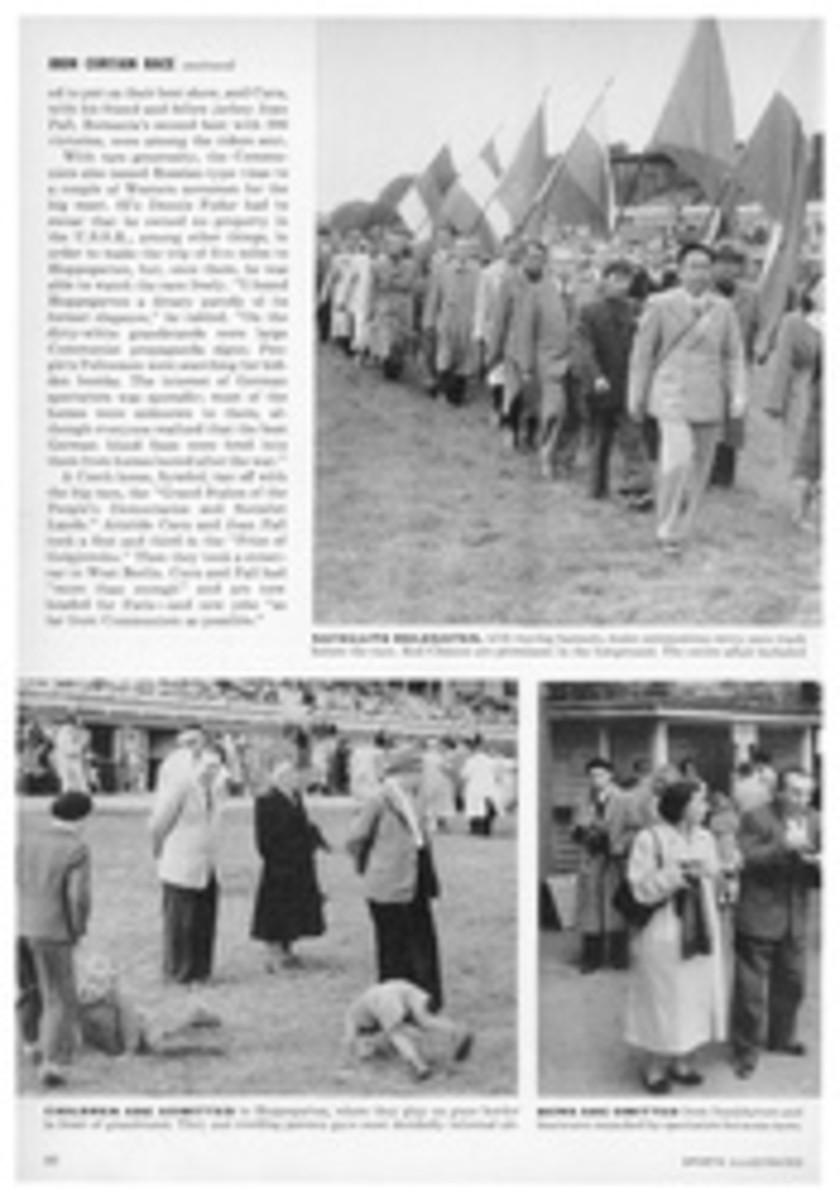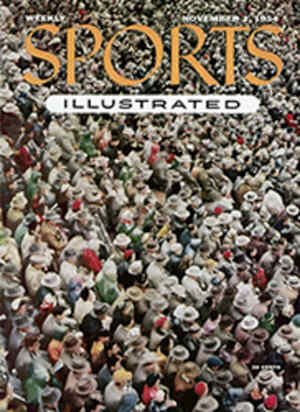
SOUPED-UP AND HOT
Back in 1947, Bill France—a driver and promoter of stock car races in the Carolinas under AAA sanction—complained to the Contest Board in Washington. The AAA, he said, was neglecting stock car races. How about some orderly supervision? The Contest Board turned him down, so France called together a group of other promoters at Daytona Beach, Fla., formed the National Association for Stock Car Auto Racing Inc. (NASCAR) and became its president. The new body divided stock car events into six groups: Grand National Circuit and Short Track Division for late-model stock cars; Sportsman Division for older stocks; Modified Division for modified stocks and the Amateur Stock Car and Midget Divisions.
RISE OF NASCAR
NASCAR grew rapidly in stature and importance and has since practically taken over stock car racing from the AAA. Starting with nine races on nine speedways in five states during 1949, NASCAR stock car (and midget) events last year paid drivers $1,500,000 prize money. This year NASCAR sanctioned 1,300 races which drew 350,000 spectators at 105 tracks in 27 states, for which 11,000 drivers, owners and mechanics received $2 million prize money. About 75% of NASCAR tracks are located east of the Mississippi, with the remainder covering Nebraska, South Dakota and Iowa and (in 1954) California.
NASCAR's National Grand Circuit Stock Car champion is Lee Petty, Randleman, N.C., with enough points (8,641) to cinch the title. Petty earned $22,715 for 33 races, with seven wins, five seconds and six third places.
Midget races are featured on the same bill as stocks, to bolster up a deflated form of auto racing in which NASCAR is not primarily interested. Midgets hit the top in 1948 and the bottom in 1951, due to a monotonous equality of power and speed which deprives actual driving skill of the importance it holds in stock car racing. Since then, public interest in midgets has revived somewhat, but NASCAR has only 68 registered midget drivers who drove a total of 24 races this season, mainly in New Jersey and Michigan. This compares poorly with the AAA's 59 midget races at 28 tracks in 10 states, which drew 205,821 spectators and paid $163,306 prize money.
NASCAR's midget champion, Chuck Arnold, Stamford, Conn., this season racked up 840 points, earned $3,053 and scored four wins, three seconds, four thirds. AAA's midget title-holder is Rex Easton, Springfield, Ill., with 2,754 points, $6,037 in prize money for three wins, seven seconds and three third places.
On the other hand, AAA stock car racing, with certain permissible modifications (axles, steering, wheels, shock absorbers and gear ratios), is confined to production autos of the last three years. Only 16 events were run this year, netting drivers $119,843 in purses. These were all of championship status, with the same points system as for AAA big car racing (SI, Oct. 25) but with points awarded for feature races only. Total stock car racing personnel at present registered with AAA is 485. Champion is Marshall Teague, Daytona Beach, Fla., who scored 2,320 points and won $13,522 prize money with five firsts, four seconds and two thirds.
FOR GLORY ALONE
AAA sprint races, however—run on half-mile to one-mile tracks and with engine displacement limited to 220 cu. in.—remain fairly active. Forty-four sprint races were sanctioned by AAA this year, drawing 522,404 fans and paying the drivers $158,280 in purses. Of these, 16 were run on the East Coast, and 28 in the Midwest. Eastern sprint champion is John Thompson, while in the Midwest, top rating goes to Pat O'Connor.
The hot rod boys are something else again, since they do not run for money but (like sports car enthusiasts) for trophies and glory alone. California alone has 12 of the 60 drag strips now operating on a nationwide basis, with Texas the runner-up with five. Currently, some 200,000 enthusiasts build or race hot rods, but at least 2 million people participate in the sport.
The National Hot Rod Association (NHRA), formed in 1951, controls much of this activity. With 25,000 members now enrolled and more than 2,000 active local hot rod clubs on its files, NHRA is a powerful organizing body. It recognizes 26 competition classes (using either gasoline or optional fuels under sub-headings such as Roadsters, Coupe/Sedans, Dragsters, etc.) and its foremost activity is on quarter-mile drag strips and, yearly, at the Bonneville Flats speed trials in Utah. After qualifying runs, drag races pit car against car to find the winner. There are no second or third places.
The top three NHRA races are Caddo Mills, Texas; Akron, Ohio and Madera, California, where this year (Oct. 9 and 10) 24 new records were officially chalked up. Top all-around NHRA driver of 1954 (though not the fastest) is Art Chrisman, of Compton, Calif., whose rear-engine DeSoto V-8 coupe set a 192.70 mph one-way record at Bonneville.
Contending body to the NHRA is the ATAA (Automobile Timing Association of America Inc.), formed a year ago to stimulate hot rod activity in the Midwest. Sparked by automotive parts manufacturer Arnold Maremont, its chairman, ATAA has some fine drag strips in the Chicago and St. Louis areas and at Lawrenceville Airport, Ill. Here, on Oct. 2 and 3, a First Annual World Series of Drag Racing was held by 350 hot rodders from 28 states before 7,000 spectators. Fastest was Arthur Arfons whose Allison-powered six-wheeler clocked 132.25 mph to win him a $1,000 college scholarship.
PHOTO
A BLUR ON THE BEACH, LEE PETTY'S CHRYSLER HITS RECORD MARK OF 118.37 MPH
PHOTO
MASTER MIDGET Rex Easton won the Midwest and National AAA titles in 1954.
PHOTO
FASTEST DRAGSTER was Ardun-Mercury powered "Bean Bandit, "owned and operated by San Diego club. Its new record: 10.86 seconds for quarter-mile.
TOP STOCK AND MIDGET RACES
STOCK CAR RACES (NASCAR)
FEB. 21: DAYTONA BEACH, FLA. (Grand National Circuit race number two)
160 miles; 4.1 miles, paved and sand; crowd 35,000. Total prize money $6,375.
1) Lee Petty ('54 Chrysler) 89.14 mph.
2) Buck Baker ('53 Oldsmobile).
3) Curtis Turner ('54 Oldsmobile).
Earnings and points: Petty $1,200-350 pts.; Baker $1,100-336 pts.; Turner $800-322 pts.
The race: Tim Flock ('54 Olds 88) was flagged as the winner at a record 90.40 mph, but was disqualified. Runner-up Petty, declared winner, qualified on measured mile at 123.41 mph.
SEPT. 6: Darlington, S.C. ("Southern 500")
500 miles; 1‚Öú miles, banked asphalt; crowd 34,000. Total prize money $27,065.
1) Herb Thomas ('54 Hudson) 94.93 mph.
2) Curtis Turner ('52 Oldsmobile).
3) Lee Petty ('54 Dodge).
Earnings and points: Thomas $6,830-1,500 pts.; Turner $6,245-1,440 pts.; Petty $2,155-1,380 pts.
The race: The "Kentucky Derby" of late model stock cars, this event was won by Thomas at record speed. First 22 finishers were all running when race was flagged.
OCT. 10: MEMPHES-ARK, SPEEDWAY, TENN. (Carnival of Speed)
250 miles; 1½ mile banked dirt; crowd 12,-000. Total prize money $10,050.
1) Buck Baker ('54 Oldsmobile) 88.83 mph.
2) Dick Rathman ('54 Hudson).
3) Lee Petty ('54 Chrysler).
Earnings and points: Baker $1,850-625 pts.; Rathman $1,150-600 pts.; Petty )-575 pts.
The race: Baker, never threatened, won handily by five laps.
STOCK CAR RACES (AAA)
SEPT. 12: IWELWAUKEE, WIS.
200 miles; one mile asphalt; crowd 16,253. Total prize money $14,800.
1) Marshall Teague (Hudson Hornet) 77.18 mph.
2) Don Miller (Chrysler).
3) Sam Hanks (Hudson). All '54.
Earnings and points: Teague $2,940-400 pts.; Miller $2,058-320 pts.; Hanks $1,470-280 pts.
The race: Teague led for 160 of the 200 laps. Jim Rathmann (Olds 88) led on first lap; Frank Mundy (Chrysler) then led to 27th lap when teammate Chuck Stevenson took lead, but quit on 40th with ignition trouble. Teague led from then to finish.
MAY 29: INDIANAPOLIS FAIRGROUND, IND.
25 miles; ¼ mile asphalt; crowd 7,000. Total prize money $7,000.
1) Potsy Goacher (B & D Body Spcl) 52.08 mph.
2) Forrest Parker (Bonnie Doone Spcl).
3) Joe Barzda (Ridenour Spcl).
Earnings and points: Goacher $775.90-150 pts.; Parker $604.80-120 pts.; Barzda $409.50-105 pts.
The race: Goacher started 50th but worked his way through field with great determination, taking lead on 63rd lap. He was never headed thereafter.
AUG. 18: SOLDIER FIELD, CHICAGO (Midwest Circuit)
62½ miles; ¼ mile asphalt; crowd 4,791. Total prize money $3,800.
1) Shorty Templeman (Whelan Spcl) no time.
2) Al Herman (Morcroft Spcl).
3) George Amick (Offenhauser Spcl).
Earnings and points: Templeman $855-150 pts.; Herman $513-120 pts.; Amick $342-105 pts.
The race: Herman led after a restart caused by a spinning car. Tolan (Anderson Spcl) passed him on third lap. Cross grabbed lead on 45th lap but Bettenhausen took him five laps later. Bettenhausen stayed ahead from 50th to 123rd lap when he crashed on south turn due to a blown engine and hit Jimmy Knight's car. Templeman in second then forged ahead to the finish.
SEPT. 10: TERRE HAUTE FAIRGROUND IND.(National Circuit)
100 miles; ½ mile dirt; crowd 3,610. Total prize money $4,000.
1) Duke Nalon (Johnny Pawl Spcl) 58.77 mph.
2) Roy Newman (Offenhauser Spcl).
3) Jack Turner (Jack Turner Spcl).
Earnings and points: Nalon $680-200 pts.," Newman $560-160 pts.; Turner $360-140 pts.
The race: Duke Nalon rode the outside rail for 200 laps after taking over the lead on the 52nd lap to win. Race was run under the yellow flag for 12 laps when George Titchnor lost a wheel on the 52nd lap.

